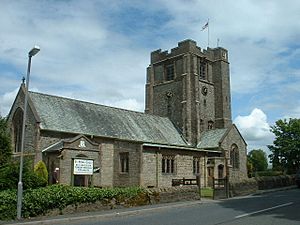St Hilda's Church, Bilsborrow facts for kids
Quick facts for kids St Hilda's Church, Bilsborrow |
|
|---|---|

St Hilda's Church, Bilsborrow, from the southwest
|
|
| Lua error in Module:Location_map at line 420: attempt to index field 'wikibase' (a nil value). | |
| Location | Bilsborrow Lane, Bilsborrow, Lancashire |
| Country | England |
| Denomination | Anglican |
| Website | St Hilda, Bilsborrow |
| History | |
| Status | Parish church |
| Dedication | Saint Hilda |
| Architecture | |
| Functional status | Active |
| Architect(s) | Henry Paley |
| Architectural type | Church |
| Style | Gothic Revival |
| Groundbreaking | 1926 |
| Completed | 1927 |
| Specifications | |
| Materials | Stone, slate roof |
| Administration | |
| Parish | Bilsborrow |
| Deanery | Garstang |
| Archdeaconry | Lancaster |
| Diocese | Blackburn |
| Province | York |
St Hilda's Church is a special church located in Bilsborrow, a village in Lancashire, England. It's an active Anglican church, which means it's part of the Church of England. It serves the local community as a parish church. St Hilda's is also part of a larger group of churches called the Fellside Team Ministry, working together with other churches like St Mary the Virgin, St Lawrence, St Eadmer, and St James.
Contents
Church History
St Hilda's Church was built between 1926 and 1927. It was designed by Henry Paley, an architect from the firm Austin and Paley in Lancaster. The church cost £11,640 to build, which would be a lot more money today (equivalent to £500,000 in 2021). The first stone of the church was laid by William Temple, who was an important bishop at the time. He later became the Archbishop of Canterbury, a very high position in the Church of England.
Church Design and Features
The church is made from stone and has a roof covered with slate. Its style is called Free Perpendicular Gothic, which is a type of church architecture with tall, thin windows and detailed stone carvings.
Inside the Church
Inside, St Hilda's has a low tower where the main parts of the church meet, called the crossing. There's a small stair turret (a little tower) on one corner of the main tower. You can see special words carved above the openings where the bells are. The pulpit, which is where the priest gives sermons, is decorated with beautiful carvings of vines.
The church also has colorful stained glass windows. Two of these windows were made by a company called Shrigley and Hunt in the 1960s or 1970s.
Musical Instruments and Bells
St Hilda's has a large pipe organ with two manuals (keyboards). This organ was built in 1938 by Wilkinson of Kendal. The church also has a ring of eight bells. All these bells were made in 1949 by Mears and Stainbank, a famous bell foundry in London called the Whitechapel Bell Foundry.
See Also
- List of ecclesiastical works by Austin and Paley (1916–44)

